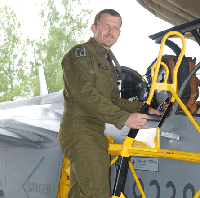The Czech air force's deployment of four Saab Gripen C fighters to provide air defence for the Baltic states has highlighted the abilities of a former Warsaw Pact military to transform itself for the demands of NATO, but also exposed the limitations of having a small fleet of combat aircraft.
With its 12 Gripen Cs currently required to deliver quick reaction alert (QRA) cover for four months from Lithuania's Siauliai air base, and permanently from their home base at Cáslav, the air force is unable to expand its mission beyond the air-to-air arena.
Seventeen of the air force's planned 21 Gripen pilots - the capped limit for its 14-strong fleet, which also includes two D-model operational trainers - are now air-to-air combat ready and QRA-qualified, while the remaining four started their conversion training last November.
"We do not have enough people or airplanes to make a more complex training," says Maj Jaroslav Míka, commander of the Czech air force's 211th Tactical Squadron and detachment commander for the Baltic mission. "In this four-month period we severely limit our training capability."
 |
|---|
"The ambition for next year is air-to-air refuelling"Maj Jaroslav Mika - Czech air force 211th Tactical Squadron commander |
In a bid to redress any training penalty incurred by mounting the parallel QRA duties, the squadron will from September participate in two exercises: firstly hosting Lockheed Martin F-16s from the Texas Air National Guard at Cáslav, and then joining the NATO Tiger Meet at Kleine Brogel air base in Belgium.
The air force also already has an eye on possible future participation in a Red Flag-series exercise in the USA, with this possibly to be achieved by sending Gripens as part of a combined detachment with the Swedish air force. However, Míka says no decisions have been made yet with regard to the squadron's aspiration.
But in a move which would support future such deployments, Czech pilots will undertake air-to-air refuelling training during 2010. "The ambition for next year is air-to-air refuelling. Then the ambition can rise," says Míka. "As users we would like to be everywhere."
The Czech Republic's current aircraft are also to receive Mode 4 identification friend-or-foe equipment and Have Quick II secure radios from later this year, but they are not expected to receive Link 16 datalinks before 2015 because of cost considerations.
With a fleet of just 14 leased Gripens, the Czech air force is currently unable to consider expanding its mission to roles such as ground-attack. However, Prague is expected to launch a fighter acquisition early in the next decade, with an outright Gripen purchase likely to be among its available options. Asked whether the nation could buy sufficient aircraft to stand up a second Gripen squadron, Míka says: "I would like to have it."
Source: Flight International























